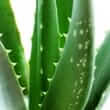Background
- Transparent gel from the pulp of the meaty leaves of Aloe vera has been used topically for thousands of years to treat wounds, skin infections, burns, and numerous other dermatologic conditions. Dried latex from the inner lining of the leaf has traditionally been used as an oral laxative.
- There is strong scientific evidence in support of the laxative properties of aloe latex, based on the well-established cathartic properties of anthroquinone glycosides (found in aloe latex). However, aloe's therapeutic value compared with other approaches to constipation remains unclear.
- There is promising preliminary support from laboratory, animal, and human studies that topical aloe gel has immunomodulatory properties that may improve wound healing and skin inflammation.
References
Natural Standard developed the above evidence-based information based on a thorough systematic review of the available scientific articles. For comprehensive information about alternative and complementary therapies on the professional level, go to . Selected references are listed below.
- Dal'Belo SE, Gaspar LR, Maia Campos PM. Moisturizing effect of cosmetic formulations containing Aloe vera extract in different concentrations assessed by skin bioengineering techniques. Skin Res Technol. 2006;12(4):241-6.
View Abstract - Ernst E, Pittler MH, Stevinson C. Complementary/alternative medicine in dermatology: evidence-assessed efficacy of two diseases and two treatments. Am.J.Clin.Dermatol. 2002;3(5):341-348.
View Abstract - Heggie S, Bryant GP, Tripcony L, et al. Phase III study on the efficacy of topical aloe vera gel on irradiated breast tissue. Cancer Nurs 2002;25(6):442-451.
View Abstract - Kim EJ, Kim HJ, Kim SG, et al. Aloe-induced Henoch-Schonlein purpura. Nephrology (Carlton). 2007;12(1):109.
View Abstract - Langmead L, Feakins RM, Goldthorpe S, et al. Randomized, double-blind, placebo-controlled trial of oral aloe vera gel for active ulcerative colitis. Aliment.Pharmacol.Ther. 4-1-2004;19(7):739-747.
View Abstract - Lee A, Chui PT, Aun CS, et al. Possible interaction between sevoflurane and Aloe vera. Ann Pharmacother. 2004;38(10):1651-1654.
View Abstract - Montaner JS, Gill J, Singer J, et al. Double-blind placebo-controlled pilot trial of acemannan in advanced human immunodeficiency virus disease. J Acquir Immune Defic Syn Hum Retrovirol 1996;12:153-157.
View Abstract - Natural Standard Research Collaboration, Chief Editors: Ulbricht C, Basch E, Natural Standard Herb and Supplement Reference - Evidence-Based Clinical Reviews, USA: Elsevier/Mosby, 2005.
- Rabe C, Musch A, Schirmacher P, et al. Acute hepatitis induced by an Aloe vera preparation: a case report. World J Gastroenterol. 1-14-2005;11(2):303-304.
View Abstract - Schmidt JM, Greenspoon JS. Aloe vera dermal wound gel is associated with a delay in wound healing. Obstetrics & Gynecology 1991;78(1):115-117.
View Abstract - Su CK, Mehta V, Ravikumar L, et al. Phase II double-blind randomized study comparing oral aloe vera versus placebo to prevent radiation-related mucositis in patients with head-and-neck neoplasms. Int.J Radiat.Oncol.Biol.Phys. 9-1-2004;60(1):171-177.
View Abstract - Syed TA, Cheema KM, Ahmad SA, et al. Aloe vera extract 0.5% in hydrophilic cream versus aloe vera gel for the measurement of genital herpes in males. A placebo-controlled, double-blind, comparative study. Journal of the European Academy of Dermatology & Venerology 1996;7(3):294-295.
- Syed TA, Afzal M, Ashfaq AS. Management of genital herpes in men with 0.5% Aloe vera extract in a hydrophilic cream. A placebo-controlled double-blind study. J Derm Treatment 1997;8(2):99-102.
- Vardy AD, Cohen AD, Tchetov T. A double-blind, placebo-controlled trial of Aloe vera (A. barbadensis) emulsion in the treatment of seborrheic dermatitis. J Derm Treatment 1999;10(1):7-11.
- Vogler BK, Ernst E. Aloe vera: a systematic review of its clinical effectiveness. Br.J Gen.Pract. 1999;49(447):823-828.
View Abstract







